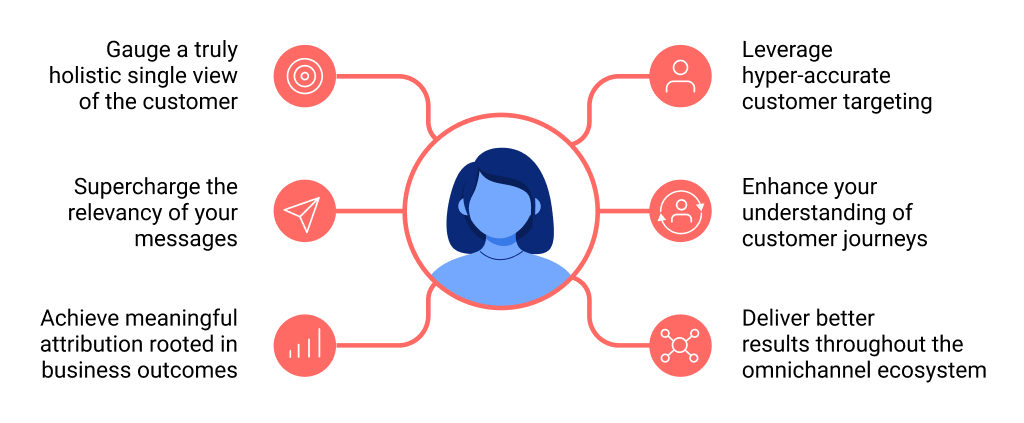Consumers have never been as protective of their data as they are now. With reliance on third-party data slowly fading, brands now have no choice but to capitalize on their first-party data.
But is first-party data going to be enough? With the correct strategies, first-party data can bring along many benefits, and all these benefits ultimately lead to high ROI on marketing spends. In this article, we deep dive into six such use cases for first-party data in the marketing environment.

Use Case 1: Leverage hyper-accurate customer targeting
This one goes without saying! First-party data is the most accurate data you will get about your customers. It’s coming directly from the customer rather than a third-party source. Therefore, with so much information about your customer in your hands, you can build robust buyer profiles. This will enable you to target the customer with highly personalized ads.
Gathering insights from your first-party data is a viable route to ensure that an individual customer feels like you know exactly what is relevant to them. By targeting them on the back of first-party insights, you are boosting conversion rates, and ultimately, your marketing ROI.
Use Case 2: Deliver better results throughout the omnichannel ecosystem
Most brands now operate multiple marketing channels, both physical and digital.
When working with an omnichannel model, your customers can come from more than one source. Their attention is scattered across those channels, so you need to measure and quantify how these channels are leading to conversions.
As you map the customer’s journey (more on this ahead in the blog post), you should be able to gather first-party data that will contribute to understanding which channel guided a specific customer to conversion, and then you can optimize that channel for that customer.
Conversely, without this data, there will be clouded clarity about which parts of the omnichannel setup to prioritize. To deliver superior cross-channel shopping experiences, measuring the source of these experiences is critical.
Use Case 3: Enhance your understanding of customer journeys
First-party data is not just the personal details of the customers. Brands often overlook this fact due to the sheer influx of data they are generating from a single channel. When a brand has an app, which is an ocean of first-party data, along with a website and/or a physical store, the data from each of these may operate in those specific silos. These silos need to be broken down so that a marketing team can identify the customer behind these interactions.
There is some merit in understanding a potential customer’s path from being a warm lead to someone who converted.
They may read an email update from your brand and decide to check your product on the website. Perhaps, a YouTube ad caught their eye, and they decided to visit your store on the weekend because of that.
You need to connect all these touchpoints to piece together how various marketing channels guide a customer’s behavior.
Another benefit is that you can then provide consistent messaging across all channels to the customer, thus giving them more incentive to convert.
Use Case 4: Achieve meaningful attribution rooted in business outcomes
Using the right data platforms, you can observe closed-loop attribution, i.e., you can attribute results to specific marketing efforts. With first-party data, you can nail down the story of what exactly occurred behind the scenes that allowed sales to double or engagement to deteriorate.
When you have this information, you can appropriately allocate resources towards the channels or marketing efforts that are successful and try to tweak those that aren’t.
You need to be able to trace a benefit to its source. First-party data allows you to do that as you have rich insights into how each stage of the customer journey influenced their decision to buy the product.
Use Case 5: Gauge a truly holistic single view of the customer
No matter which industry you operate in, matching your customer’s expectations and providing them value will be a priority, so why not try to create a culmination of your customer’s behavior, attributes, likes, and preferences?
You can add to that “single view” of the customer each time they engage with the brand. All these nuggets of data, when pulled together to create a singular view of the customer, can be a game-changer.
When you have data points from each time the customer has checked your website, browsed your app, or even spoken to your customer care representative, you are stepping one inch closer to understanding what converts your customer’s attention to interest, desire, and finally, action.
All that’s left is to create targeted campaigns based on these insights flowing from a single view of the customer.
Use Case 6: Supercharge the relevancy of your messages
When you constantly collect data about your customers and track their behaviors, you can shape intimate and personalized customer experiences. Enriching all your first-party data points across all physical and virtual marketing channels will help you tailor your approach towards each customer or segment of customers.
That ability to understand the customer and truly discover who they are in real time to create strong relevancy will ultimately boost your ROIs.
Ready to leverage your first-party data for amazing marketing outcomes?
Your first-party data need not just be the lifeboat in a precarious cookie-less society; it can be the entire ship. So, if you want to experience the benefits of robust first-party data marketing, we are here to give you a peek. Holler for a demo, we have you covered!
You may also like
Essential resources for your success
















